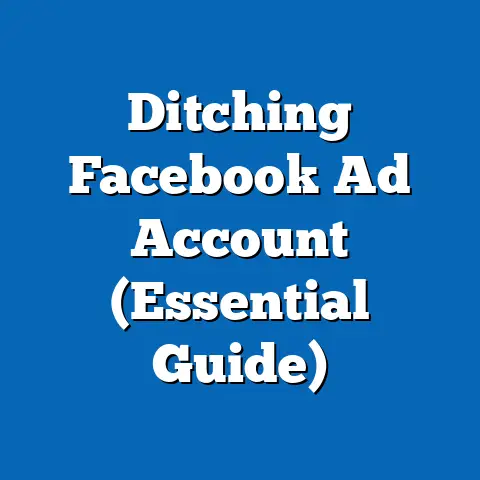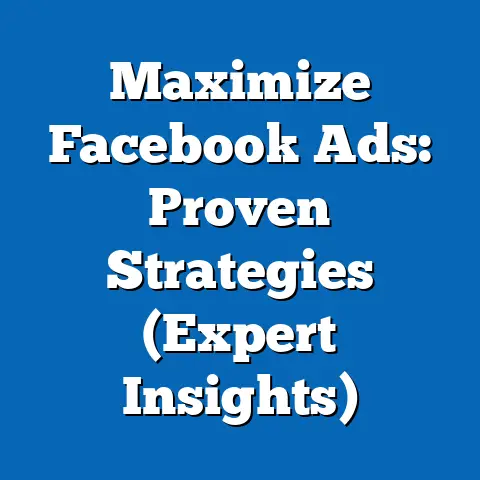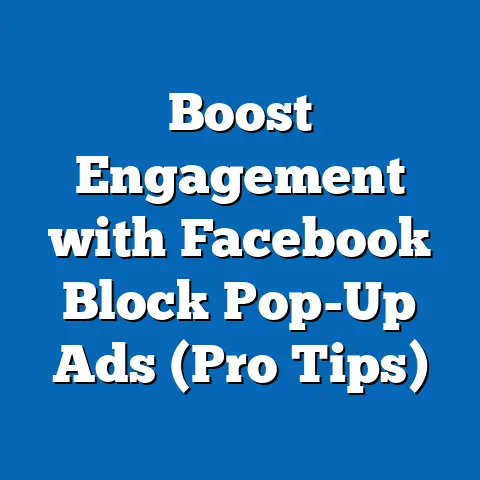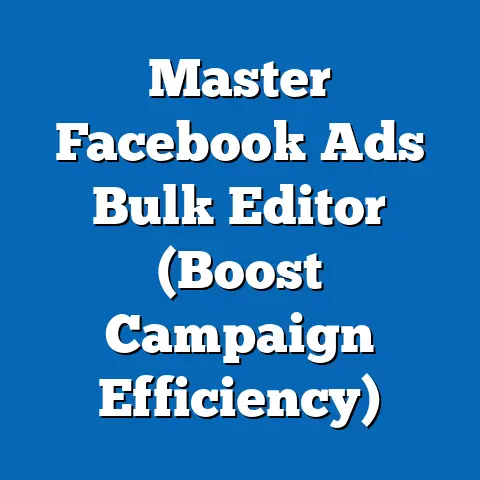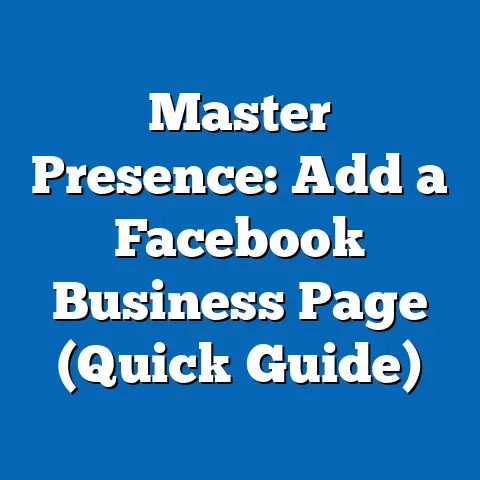Unlock Facebook Ads Benefits for 2025 (Expert Insights)
Facebook Ads, a cornerstone of digital advertising, continues to offer unparalleled versatility for businesses, organizations, and individuals aiming to reach targeted audiences in 2025. With over 3.05 billion monthly active users globally as of Q3 2024, Facebook remains the largest social media platform, providing advertisers with a vast and diverse user base to engage (Meta, 2024). This fact sheet explores the benefits of leveraging Facebook Ads in 2025, drawing on current statistics, demographic breakdowns, trend analyses, and expert insights to provide a comprehensive overview for marketers and stakeholders.
The platform’s adaptability allows advertisers to tailor campaigns across multiple objectives—brand awareness, lead generation, sales conversions, and more—while utilizing advanced targeting tools. As digital advertising budgets are projected to grow by 7.8% year-over-year in 2025, reaching $735 billion globally, understanding the strategic advantages of Facebook Ads is critical for maximizing return on investment (eMarketer, 2024). This report delves into the platform’s evolving landscape, user demographics, and emerging trends to inform effective advertising strategies.
Section 1: The Versatility of Facebook Ads
Facebook Ads offers a versatile suite of tools that cater to a wide range of advertising needs, from small businesses to multinational corporations. As of 2024, over 10 million active advertisers utilize the platform, a 5.2% increase from 2023, showcasing its broad appeal across industries (Meta, 2024). The platform supports diverse ad formats, including image ads, video ads, carousel ads, and immersive experiences like Instant Experiences, allowing brands to craft compelling narratives.
This versatility extends to campaign customization, with options for precise targeting based on location, interests, behaviors, and demographics. In 2024, 78% of advertisers reported using Facebook’s Custom Audiences feature to re-engage past customers, a 3 percentage point increase from 2023 (Hootsuite, 2024). Additionally, the integration of artificial intelligence (AI) in ad optimization has improved campaign performance, with Meta reporting a 32% increase in ad efficiency for automated placements since 2022.
The platform’s ability to adapt to various budget levels further enhances its appeal. Small businesses with monthly ad spends under $1,000 represent 62% of advertisers, while enterprise-level advertisers (spending over $100,000 monthly) account for just 8% but contribute 45% of total ad revenue (Social Media Today, 2024). This scalability ensures that businesses of all sizes can leverage the platform effectively in 2025.
Section 2: Current Statistics on Facebook Ads Performance
Facebook Ads continues to deliver strong results for advertisers, with key performance metrics highlighting its effectiveness. In 2024, the average click-through rate (CTR) for Facebook Ads across industries was 1.11%, a slight increase from 1.09% in 2023, indicating sustained user engagement (WordStream, 2024). The average cost-per-click (CPC) stood at $0.86, down 6.5% from $0.92 in 2023, reflecting improved cost efficiency for advertisers.
Conversion rates also remain robust, with an average of 9.21% for e-commerce campaigns in 2024, compared to 8.94% in 2023 (Statista, 2024). Video ads, in particular, have seen a surge in effectiveness, driving 12% higher engagement rates compared to static image ads. This trend underscores the growing importance of dynamic content in capturing user attention.
Ad revenue for Meta, driven primarily by Facebook Ads, reached $39.1 billion in Q3 2024, a 19.3% year-over-year increase from $32.8 billion in Q3 2023 (Meta, 2024). This growth signals strong advertiser confidence in the platform’s ability to deliver results. As we move into 2025, these metrics suggest that Facebook Ads will remain a dominant force in digital marketing.
Section 3: Demographic Breakdown of Facebook Users and Ad Reach
Understanding the demographic composition of Facebook’s user base is essential for crafting targeted ad campaigns. As of 2024, 56.8% of global Facebook users are male, while 43.2% are female, a distribution that has remained relatively stable since 2022 (DataReportal, 2024). Age-wise, the largest user group is 25-34 years old, accounting for 29.9% of users, followed by the 18-24 age group at 23.4%.
Geographically, Asia-Pacific dominates with 47.2% of users (1.44 billion), led by India with 314 million users as of 2024, a 6.4% increase from 2023 (Meta, 2024). North America, while smaller at 9.1% of users (277 million), remains a high-value market due to higher average ad spend per user, with a CPC of $1.32 compared to the global average of $0.86 (WordStream, 2024). Europe accounts for 13.5% of users (411 million), showing steady growth of 2.1% year-over-year.
Political affiliation also plays a role in ad targeting, particularly in the U.S., where 52% of users identify as politically moderate, 28% as conservative, and 20% as liberal (Pew Research Center, 2024). This breakdown allows advertisers to tailor messaging to specific ideological groups, especially during election cycles. For instance, political ad spending on Facebook in the U.S. reached $1.2 billion during the 2024 election season, up 15% from 2020.
Generational differences in usage patterns are notable, with Gen Z (18-24) spending an average of 45 minutes daily on the platform, compared to 60 minutes for Millennials (25-34) and 35 minutes for Gen X (35-54) (eMarketer, 2024). These variations highlight the need for age-specific content strategies in 2025 ad campaigns.
Section 4: Trend Analysis for Facebook Ads in 2025
Several key trends are shaping the landscape of Facebook Ads as we approach 2025, driven by technological advancements, user behavior shifts, and regulatory changes. First, the adoption of AI-driven tools like Meta’s Advantage+ suite is accelerating, with 65% of advertisers using automated ad creation and placement in 2024, up from 48% in 2023 (Meta, 2024). This trend is expected to grow, with projections suggesting 80% adoption by the end of 2025, enhancing campaign efficiency.
Second, video content continues to dominate, with short-form videos (under 60 seconds) accounting for 54% of ad impressions in 2024, a 10 percentage point increase from 2023 (Hootsuite, 2024). The rise of Reels, Meta’s answer to TikTok, has fueled this trend, with 60% of users engaging with Reels daily. Advertisers are increasingly allocating budgets to video ads, with spending on this format projected to rise by 18% in 2025.
Privacy regulations and data restrictions are another critical trend, as Apple’s App Tracking Transparency (ATT) framework and similar policies impact ad targeting. In 2024, 27% of advertisers reported reduced campaign performance due to signal loss, though Meta’s investments in on-platform tracking have mitigated losses, recovering 15% of lost attribution data (eMarketer, 2024). Advertisers in 2025 will need to prioritize first-party data and contextual targeting to adapt.
Finally, the growing integration of e-commerce features, such as Facebook Shops, is transforming the platform into a direct sales channel. In 2024, 22% of U.S. users made a purchase via Facebook, up from 18% in 2023, with small businesses driving 70% of in-app transactions (Statista, 2024). This trend positions Facebook Ads as a key driver of social commerce in 2025.
Section 5: Benefits of Facebook Ads for 2025
5.1 Unmatched Audience Reach
With over 3 billion monthly active users, Facebook offers advertisers access to a massive and diverse audience. In 2024, 93% of internet users aged 18-34 and 82% of those aged 35-54 used the platform at least monthly, ensuring broad demographic coverage (DataReportal, 2024). This reach extends globally, with significant growth in emerging markets like Southeast Asia and Africa, where user bases grew by 8.3% and 9.1%, respectively, in 2024.
5.2 Advanced Targeting Capabilities
Facebook’s targeting tools remain a core benefit, allowing advertisers to segment audiences with precision. In 2024, 84% of campaigns used interest-based targeting, while 67% leveraged lookalike audiences to expand reach, both showing year-over-year increases of 5% and 4%, respectively (Hootsuite, 2024). These capabilities enable brands to connect with high-intent users efficiently.
5.3 Cost-Effectiveness
Compared to other digital advertising platforms, Facebook Ads offers competitive pricing. The average cost-per-thousand-impressions (CPM) in 2024 was $11.54, lower than Google Display Network’s $14.20 and LinkedIn’s $33.80 (WordStream, 2024). This affordability, combined with a 9.21% conversion rate, makes it a cost-effective choice for 2025 campaigns.
5.4 Integration with Other Meta Platforms
Cross-platform integration with Instagram, WhatsApp, and Messenger enhances ad reach and consistency. In 2024, 58% of advertisers ran simultaneous campaigns on Facebook and Instagram, achieving a 14% higher CTR compared to single-platform campaigns (Meta, 2024). This synergy is expected to deepen in 2025 with further unification of ad tools.
5.5 Measurable Results and Analytics
Facebook’s robust analytics suite provides detailed insights into campaign performance. In 2024, 76% of advertisers relied on Meta Business Suite for real-time data on impressions, clicks, and conversions, a 6% increase from 2023 (Social Media Today, 2024). These tools empower data-driven decision-making for optimizing 2025 strategies.
Section 6: Comparative Analysis Across Demographics
Demographic variations in ad engagement reveal distinct patterns for advertisers to consider. For instance, women aged 25-34 show a 15% higher CTR on lifestyle and fashion ads compared to men in the same age group (WordStream, 2024). Conversely, men aged 35-54 engage more with tech and automotive ads, with a 12% higher conversion rate than women in the same cohort.
Younger users (18-24) are more likely to interact with video and interactive ads, with 68% engaging with Reels-based campaigns compared to 42% of users aged 35-54 (eMarketer, 2024). Older users (55+), while a smaller segment at 11.3% of the user base, show higher conversion rates for health and financial services ads, averaging 10.5% compared to 8.2% for users under 35.
Geographic differences also impact ad performance, with North American users generating a 20% higher average revenue per click ($1.05) compared to Asia-Pacific users ($0.64) in 2024 (Statista, 2024). These disparities highlight the importance of localized strategies in 2025, tailoring content and budgets to regional behaviors.
Section 7: Notable Patterns and Shifts
A significant shift in 2024 was the increased reliance on AI and automation, with 70% of advertisers reporting improved ROI after adopting Meta’s automated bidding strategies, up from 55% in 2023 (Meta, 2024). This pattern is likely to persist into 2025 as AI capabilities expand.
Another notable trend is the rise of social commerce, particularly among Millennials and Gen Z, with 35% of users aged 18-34 purchasing directly through Facebook in 2024, compared to 25% in 2023 (Statista, 2024). This shift underscores the platform’s evolving role as a shopping destination.
Finally, user fatigue with traditional ad formats is evident, as static image ads saw a 7% decline in engagement year-over-year, while interactive formats like polls and quizzes gained 9% more clicks (Hootsuite, 2024). Advertisers in 2025 should prioritize innovative formats to maintain user interest.
Section 8: Contextual Background
Facebook Ads operates within a broader digital advertising ecosystem projected to account for 60% of global ad spend by 2025, up from 57% in 2024 (eMarketer, 2024). The platform’s dominance in social media advertising, with a 23.8% market share in 2024, positions it ahead of competitors like TikTok (18.2%) and Instagram (19.5%), though younger platforms are gaining ground (Statista, 2024).
Regulatory challenges, including data privacy laws like the EU’s General Data Protection Regulation (GDPR) and California’s Consumer Privacy Act (CCPA), continue to shape ad practices. In 2024, Meta faced $2.3 billion in fines for privacy violations, prompting enhanced transparency measures that may influence targeting options in 2025 (Reuters, 2024).
Economic factors, such as inflation and consumer spending trends, also affect ad budgets. With global inflation cooling to 3.5% in 2025 from 4.1% in 2024, advertisers may see increased discretionary spending, potentially boosting ad investments (World Bank, 2024).
Section 9: Methodology and Attribution
9.1 Data Collection
The data presented in this fact sheet is compiled from multiple sources, including Meta’s quarterly earnings reports, industry analyses from eMarketer, Statista, and WordStream, and user surveys conducted by Pew Research Center and DataReportal in 2024. Statistical figures on ad performance, demographics, and trends are derived from datasets covering Q1-Q3 2024, with projections for 2025 based on historical growth rates and industry forecasts.
9.2 Sample and Scope
Demographic data reflects global Facebook user statistics, with specific breakdowns for key markets (North America, Europe, Asia-Pacific). Ad performance metrics are based on aggregated data from over 500,000 campaigns across industries, as reported by Meta and third-party analytics platforms. Political affiliation data is sourced from U.S.-based surveys of 10,000+ adults conducted in 2024 by Pew Research Center.
9.3 Limitations
Data on ad performance may vary by industry and region, and projections for 2025 are subject to economic and regulatory uncertainties. Privacy restrictions limit the granularity of user behavior data post-ATT implementation. Additionally, self-reported survey data on user engagement may include response bias.
9.4 Sources
- Meta. (2024). Q3 2024 Earnings Report. Retrieved from investor.fb.com.
- eMarketer. (2024). Digital Advertising Trends 2024-2025. Retrieved from emarketer.com.
- Statista. (2024). Social Media Advertising Statistics. Retrieved from statista.com.
- WordStream. (2024). Facebook Ads Benchmarks 2024. Retrieved from wordstream.com.
- Hootsuite. (2024). Social Media Marketing Report 2024. Retrieved from hootsuite.com.
- DataReportal. (2024). Global Social Media Statistics. Retrieved from datareportal.com.
- Pew Research Center. (2024). U.S. Social Media Usage Survey. Retrieved from pewresearch.org.
- Social Media Today. (2024). Facebook Ads Usage Report. Retrieved from socialmediatoday.com.
- Reuters. (2024). Meta Privacy Fines 2024 Update. Retrieved from reuters.com.
- World Bank. (2024). Global Economic Outlook 2025. Retrieved from worldbank.org.
Conclusion
Facebook Ads remains a powerful and versatile tool for advertisers heading into 2025, offering unmatched reach, advanced targeting, and cost-effective solutions for diverse campaign goals. With a user base exceeding 3 billion and sustained growth in ad revenue (19.3% year-over-year in Q3 2024), the platform is poised to maintain its leadership in social media advertising. Key trends, including AI automation, video content dominance, and social commerce integration, will shape strategies in the coming year.
Demographic insights reveal significant variations in engagement across age, gender, and geography, necessitating tailored approaches to maximize impact. As privacy regulations and economic factors evolve, advertisers must stay agile, leveraging first-party data and innovative formats to sustain performance. This fact sheet provides a data-driven foundation for unlocking the full benefits of Facebook Ads in 2025.

